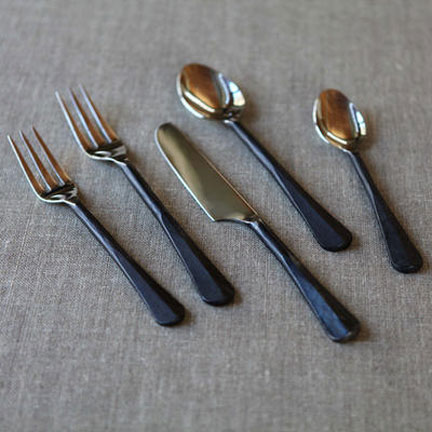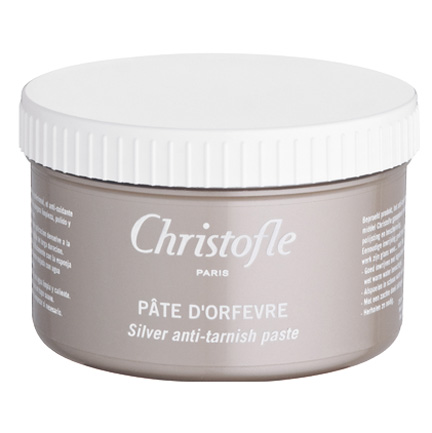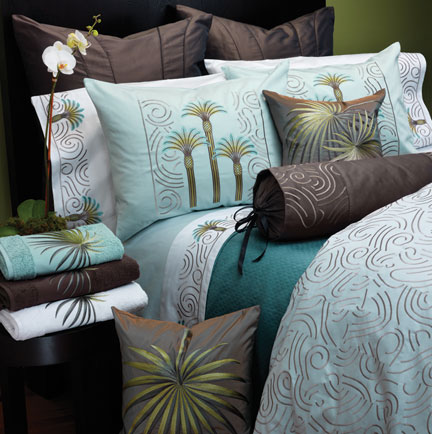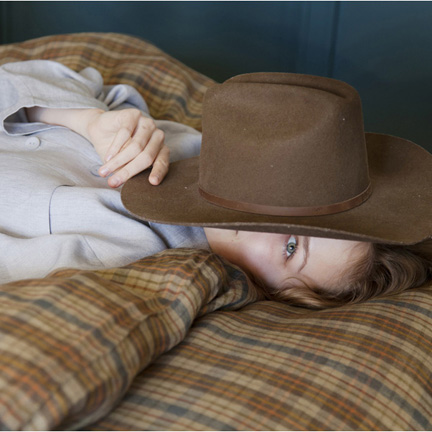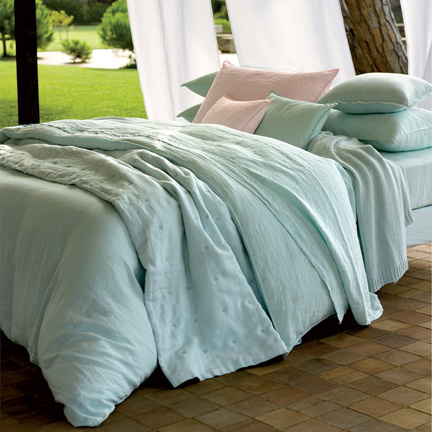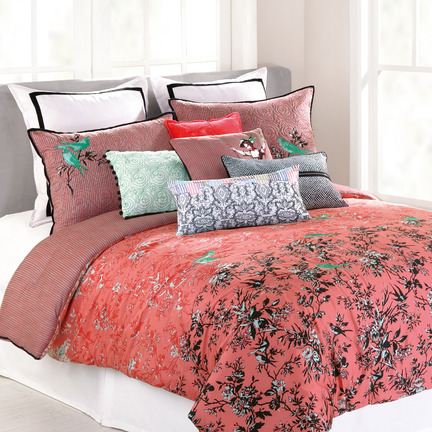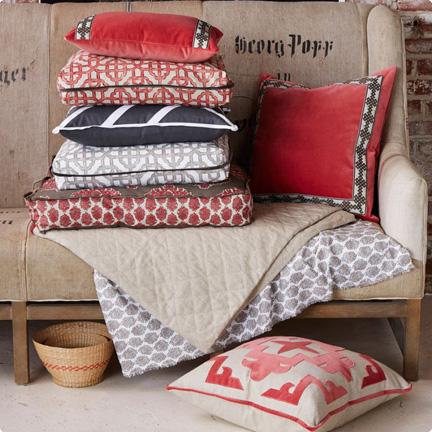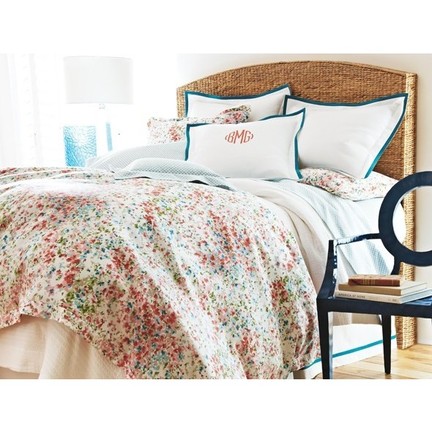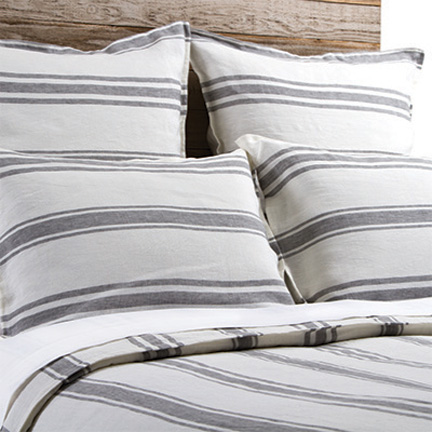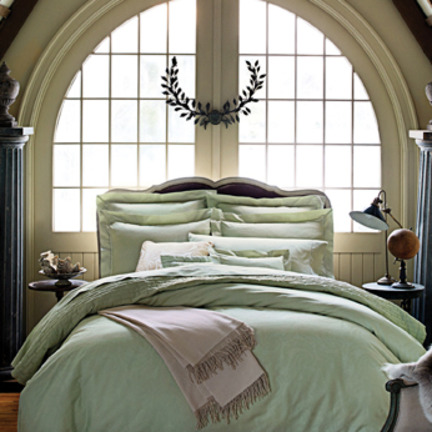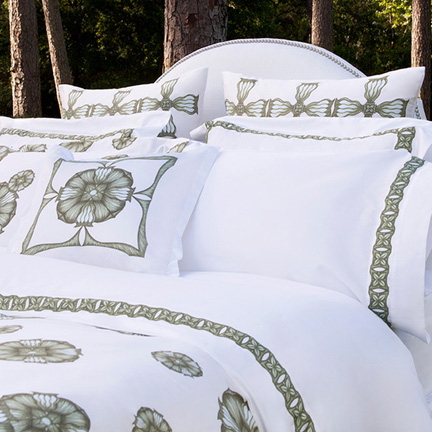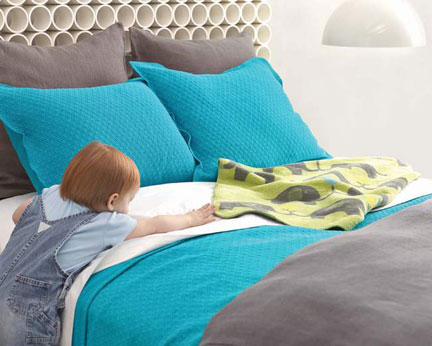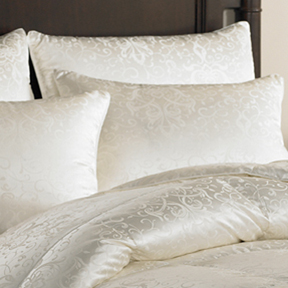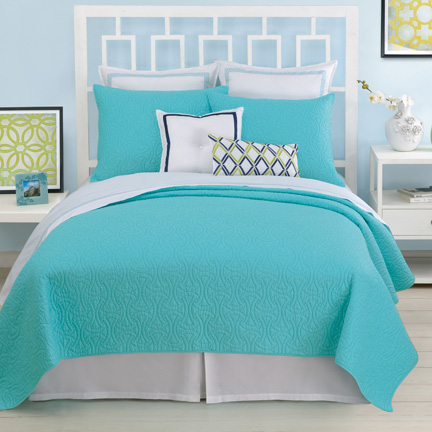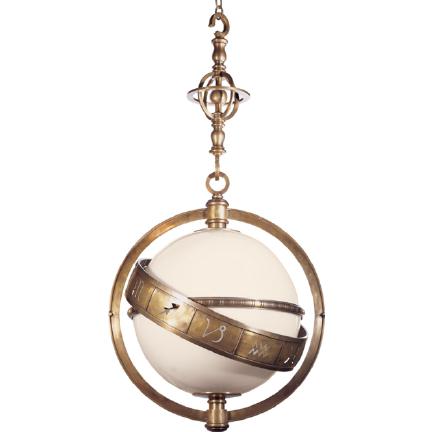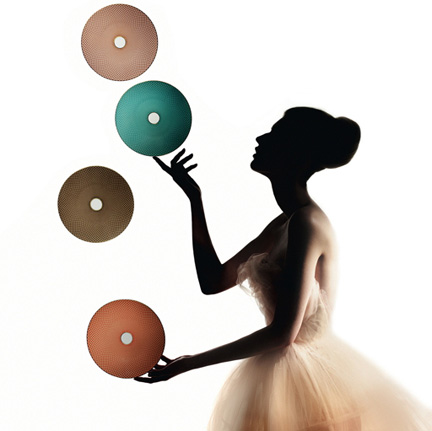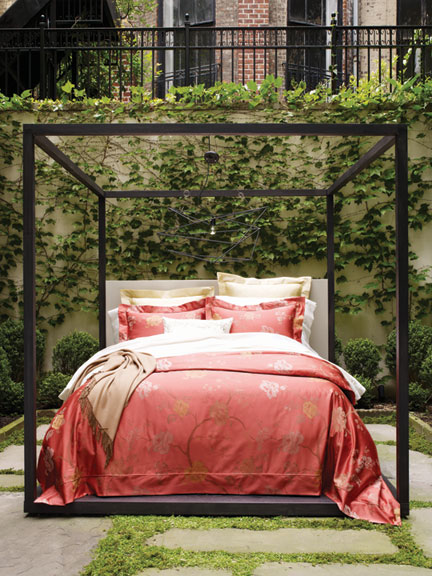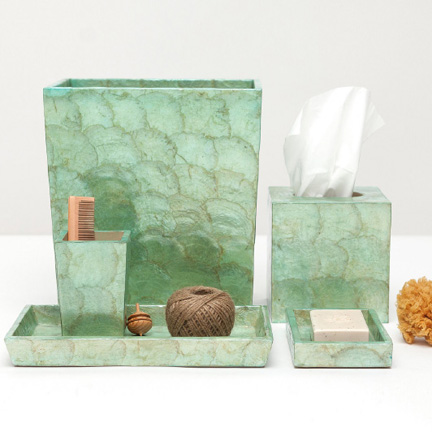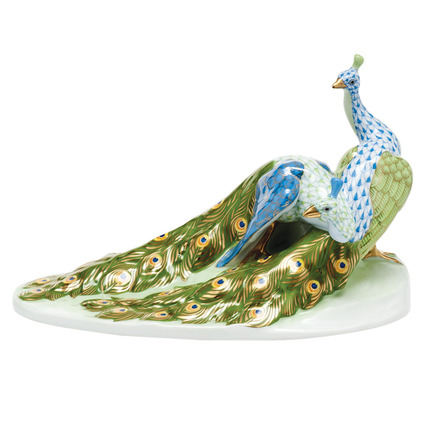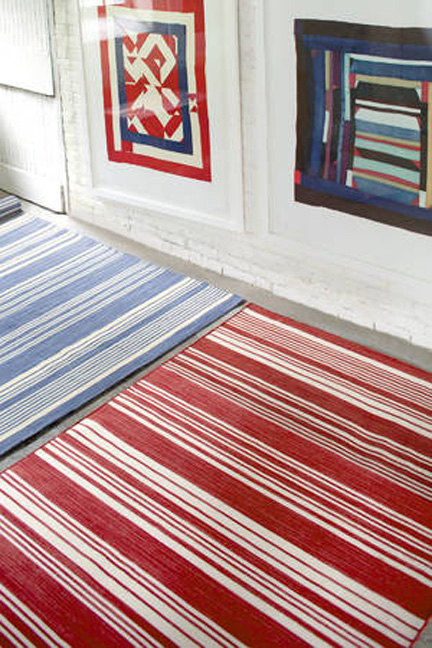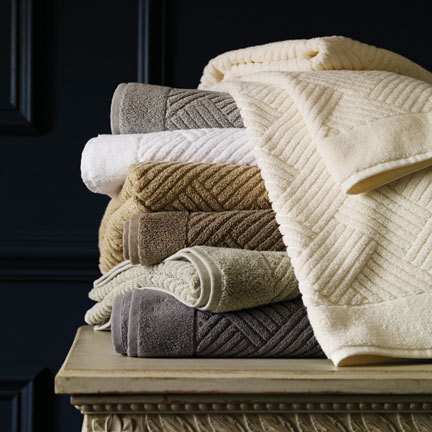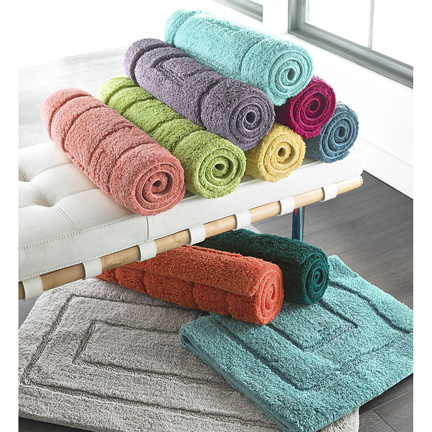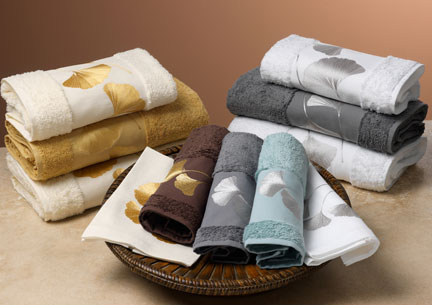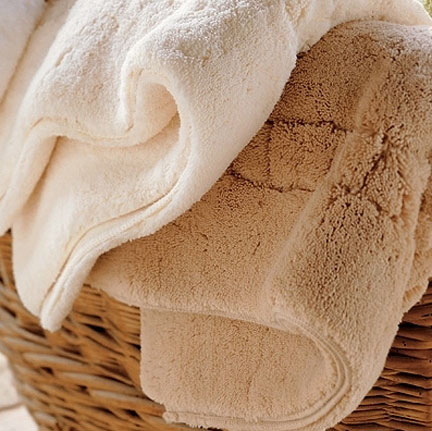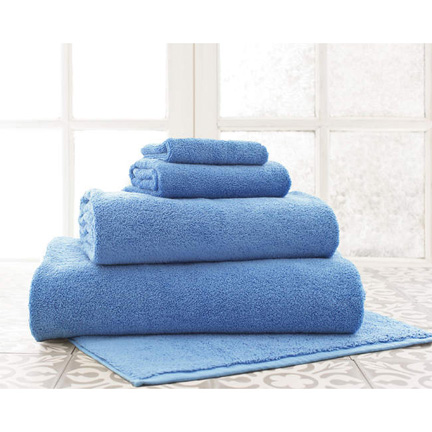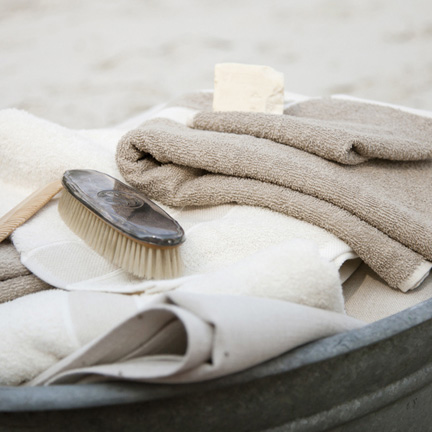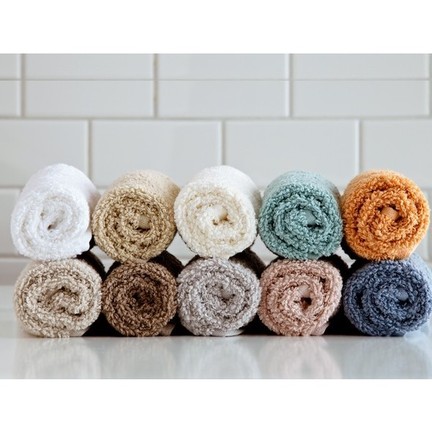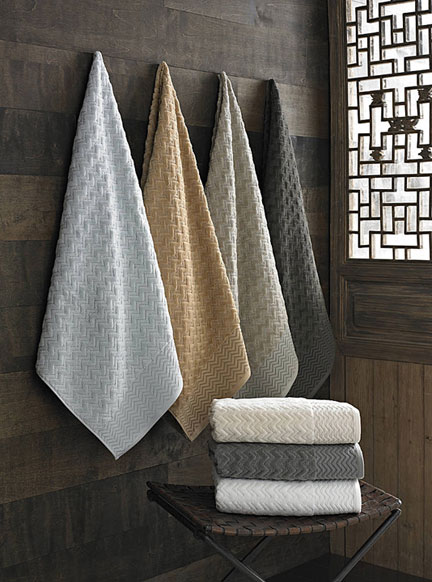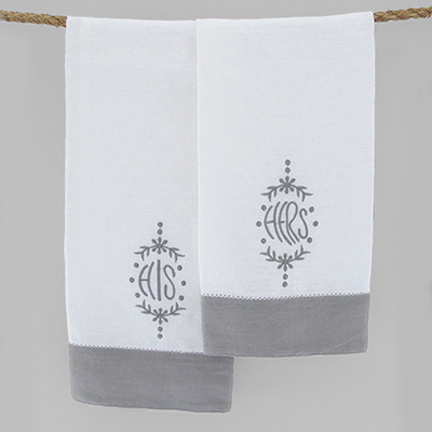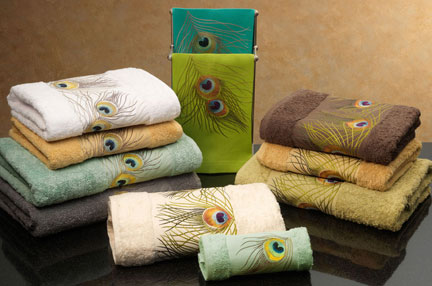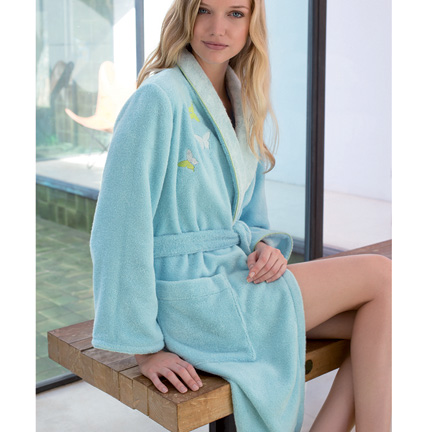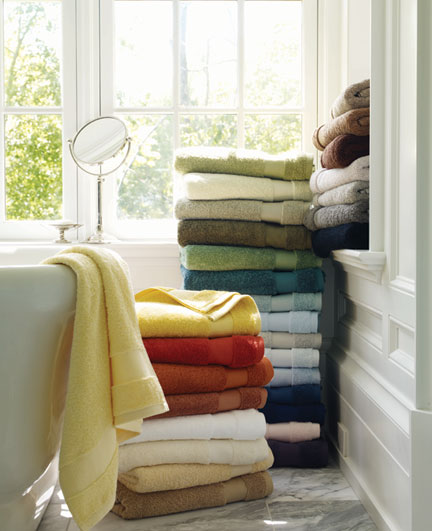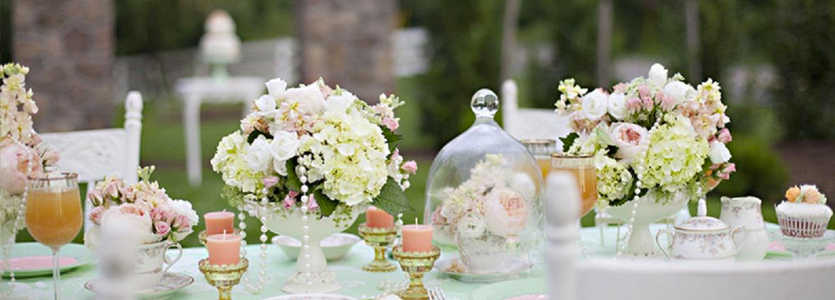Save to...
Guide to Choosing Rugs
The perfect rug will pull your room together, so many designers start rooms by choosing the rug. To get you on your way, here are a few practical tips:
Choosing the Right Size and Shape
– Start by making a floorplan. Measure your room and add all the furniture you’re planning to put in it.
If you’d like a smaller rug, center it under the dining table, coffee table, or main lighting fixture in the room.
If you’d like a larger rug, block out any areas that you know will get a lot of floor traffic and place it in the middle of the space that’s left over. Sofas and chairs can be placed either completely on top of the rug, just with the two front legs on the rug, or a mix of both.

– Allow one to two feet between the edges of the rug and the perimeter of the room. For example, if your room is 12 x 14 ft, and you want a large rug to cover the room, go with a 9 x 12 ft rug. Let the floor frame your rug.

– Larger rugs will make rooms feel larger. They visually embrace the space better.

– Rugs typically come in the following standard sizes: 3 x 5 ft, 4 x 6 ft, 5 x 8 ft, 6 x 9 ft, 8 x 10 ft, 9 x 12 ft, 12 x 14 ft.
– Rectangular rugs look best in rectangular rooms, square rugs look best in square rooms, and round rugs look best in foyers and kids’ rooms.
– In bedrooms, place rugs either completely under the bed or have them cover the bottom 2/3 of the bed. Choose a rug that’s at least two feet wider than your bed so that you can step onto something soft when you get up.

– In kitchens, use 2′ x 3′ rugs in front of the sink. In larger spaces, a runner can instantly warm up a room.
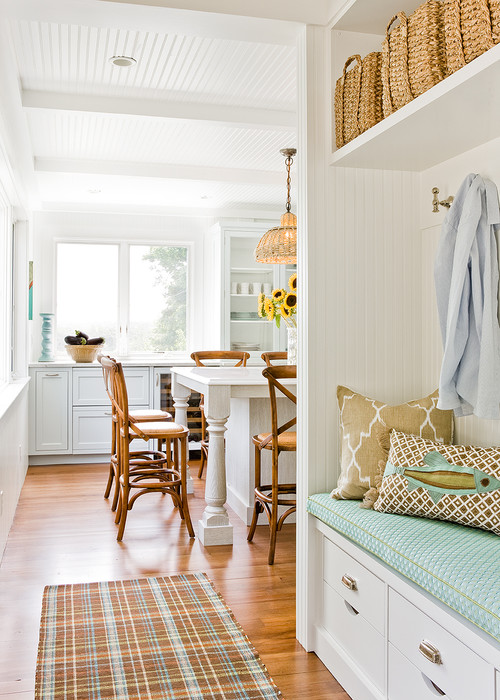
– In dining rooms, rugs, should always be centered under the dining table.

Choose the Right Material
– Entryways: in high-traffic entryways, choose a flat-weave rug that can easily be cleaned. For more formal settings, a wool rug sets an elegant tone for the rest of the house.
– Hallways: synthetics and flat-weave rugs
– Living rooms and dining rooms: cotton or wool rugs
– Kitchens and outdoor: synthetics and flat-weave rugs

– Bedrooms: soft textures like wool and chenille
Choose the Right Design
– Solid rugs are more calming, and they work with either solid or patterned furniture. Choose a color that complements other accessories in the room, like your artwork or your pillows.
– Patterned designs energize a space, and they look stunning with solid furniture.
– In colder climates, go with rich, saturated colors to create a cozy and intimate mood. Warm colors like yellow, orange, and red add warmth to rooms with indirect light.

– Lighter colors open up smaller spaces and make them feel larger. In warmer climates, use ivories, blues, and greens to create a soothing atmosphere.

Caring for your Rug
– Use a rug pad. This will extend the life of your rug and make sure it does not slip around.
– Vacuum regularly.
– Rotate rug periodically to even out the wear.
– Trim any loose threads with scissors.
– Clean spills immediately by blotting with a clean cloth or paper towel. Test rug cleaners on an inconspicuous spot before using.
– Professional cleaning recommended on wool rugs.
Looking for a rug? To view our entire selection of rugs, click here.
Product Review: L’Objet Turtle Candle
Beauty, elegance and imagination are embodied in L’Objet‘s unique style, and their stunning and sensuous Turtle Candle is no exception. But what makes this candle so different? We asked Eve to tell us after she received hers:

What were your first impressions when you received the package?
The presentation was beautiful. It was wrapped in a black box with gold trim, in L’Objet‘s signature packaging.
What did you think of the Limoges porcelain exterior?
I was so impressed by the canister. It has the real shape, color, and texture of a turtle shell! Moving your hand across the top, it feels like it really could be one. The intricately painted details and 14k gold edges really make it unlike any other candle.
How did it smell?
The Pink Champagne scent truly is intoxicating. The candle is very richly saturated, but the fragrance is light and sweet. While slightly floral, the smell was very fresh and crisp, like rain.
Did you light the candle right away?
Of course! I like candles because they make my home feel warm and relaxed, so I lit this one as soon as I got home from work. The scent is very clean and soothing, and within only a minute of lighting the candle, it filled the whole room with fragrance. It was the perfect way to unwind at the end of the day.
Would you recommend this candle to others?
Absolutely; I say buy two! It is so beautiful and unique that it makes a perfect gift, and it already comes so nicely packaged. But the minute you see or smell it, you will be glad you got one for yourself, too. The best part is, while it will burn up to 50 hours, the gorgeous box will last years after the candle is gone.
Guide to Choosing Lighting
The key to creating a comfortable lighting environment is to use a mix of general lighting (also called ambient), task lighting (for specific activities, like reading) and accent lighting (to highlight objects or architectural features).
Ambient Lighting
What are recessed lights?
Starting from the ceiling, the most common type of lighting are recessed lights, which are usually installed by a contractor. Also called can lights or downlights, they look clean overhead and they offer a practical and affordable way to light up a room, but don’t overdo it … you can always add task and accent lighting later.

What are ceiling mounted fixtures?
Ceiling mounted fixtures include chandeliers, pendants, flush mount fixtures. They can cast light upward or downward, and they add an important decorative element to a room.
– Generally, chandeliers work well in large rooms with high ceilings. They are perfect for larger spaces like entryways, dining rooms, living rooms. If you do not have any furniture underneath your chandelier, remember to hang it up high so that the bottom is at least 6’6″ – 7′ from the floor.

Pendants are great for hallways, especially on the first floor. They light your pathways and add visual interest to these spaces. Pendants will also make a kitchen feel more like a living space.

Finally, flush mount fixtures are ideal for spaces with lower ceilings. We love them in secondary bedrooms, mudrooms, large closets, and laundry areas. But of course, they can look good anywhere:

Where do you use wall lamps?
Wall lamps are frequently used in pairs – to frame mirrors, console tables, and sideboards. They look smashing in powder rooms and master bathrooms.

As they are installed closer to eye level, it’s a good idea to look for fixtures that look beautiful during the day. We love ones with mirrored finishes!
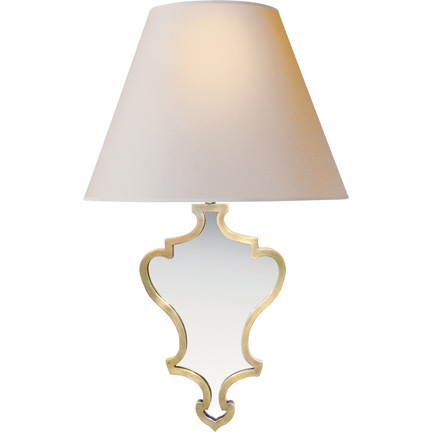
Task Lighting
What are good task lighting fixtures?
For task lighting, the two most popular kinds of fixtures are floor lamps and table lamps. If you are planning to install floor lamps in the middle of a room, remember to ask your electrician to install outlets nearby. As for table lamps, this is a good way to bring in a bit of color into a room.

Accent Lighting
How do you light artwork?
The most common ways to light artwork is with track and recessed lighting because you have so much control over large areas and they are infinitely flexible. But for lighting individual pieces, our favorite method is to use picture lights. They can not only enhance the rest of the lighting fixtures in your space, but they will make your piece look precious.

Outdoor Lighting
What do I need to know about outdoor lighting?
Outdoor lighting is key in creating a welcoming environment as you come up to your home, but it also does something else: it adds an element of security. Here are a few tips to get you started:
– Lead the way to your front door by using pathway lights that direct the light downward. Do the same in the back as you move into your yard.
– Add bits of lighting around your flower beds.
– Welcome guests to your front door with a large ceiling mount fixture (pendant lamps are great for two-story homes) or sconces.
– Install sconces around your garage entrance and deck.
– Accent special trees or water features using spotlights.
– Use motion-sensor lights to increase security at night.

Energy-Efficient Lighting
What are LED lights?
LED (light-emitting diode) lights are super-efficient forms of lighting. Compared to incandescent lights, they consume much less energy, last longer, and turn on more quickly. As they are becoming the standard in residential lighting, you’ll probably be seeing them more frequently when you shop for lighting.
I’m confused by the kinds of LED lights available. What should I get?
LED lights are available in different color temperatures so you can choose whether you’d like a warmer or cooler light. The lower the number, the warmer the light. Here are some suggested guidelines:
– 2700K (warm white) – ideal for homes, restaurants, and hotel lobbies
– 3000K (warm white, slightly cooler) – ideal for stores, offices
– 4000k (neutral white) – ideal for showrooms, offices
– 5000k (cool white) – ideal for museums, jewelry stores, hospitals
In the home, we usually recommend using 2700K throughout. If you prefer a slightly whiter light for the kitchen, or if you have a more modern style, then go with a cooler white.
And this is what they look like:
Lighting Placement
KITCHEN LIGHTING
I’m designing a new kitchen and I’d like to learn how to light it properly. Where should I start?
The best kitchens have a combination of overhead lighting (such as recessed lights) and task lighting (like undercabinet lights or pendants above the island) so you can avoid having strong shadows. Aesthetically, pendant lights work well because they fill up the vertical space between the island and the ceiling.

How many pendants should I hang over my island?
Pendants look best in odd numbers, approximately 4 feet are apart. So, if you had a 6 – 8 ft island, you could hang two lamps above it, whereas for a 9 ft island and above, you’d be better off with three. For a modern look, choose a cluster of smaller pendants (around 5 in diameter); traditional rooms look best with larger lamps (around 14 in diameter). Remember to hang them approximately 30 – 36″ above the island so that you can chat comfortably while you are seated.
How many recessed lights do I need in my kitchen?
If there are no tall cabinets in the perimeter of the room, place them 2 feet away from the wall, and every 6 or 7 feet apart.
– You do not need any lights right when you step into a room, so the first one can be placed about 3 – 4 feet inside a room.
– For hallways that are 9 – 14 feet, you’d need two recessed lights; above that, you’d need three or more. The smaller lights look more elegant, so we usually use 4 in – 5 in diameter lights.
If there are upper cabinets, move them farther away from the wall so they are not shining directly at the edge of your countertop. We usually center them along the walkway, so they are 3.5 – 4 feet from the wall.
Where do I need additional task lighting?
Under cabinets (to illuminate your countertops) and above the sink.

DINING ROOMS
How do I light my dining room?
We prefer dining rooms to feel more relaxed, so we usually just go with one ceiling fixture (like a chandelier) and two sconces on the wall on either side of the buffet or side table. We do not used recessed lights unless the room is very large (more than 18 ft along any edge).

BEDROOMS
How much light do I need in a bedroom?
To determine the total number of watts you need in the room, multiply the width of the room (in feet) x the length of the room (in feet) x 1.5.
So for a 14 ft x 14 ft room (14 x 14 x 1.5 = 294), you’d need approximately 300 watts. This is a lot of lighting, but you would spread this over different lighting sources so you can layer the brightness. For example in a bedroom, you could do a flushmount ceiling lamp (for general lighting, with 2 x 60 watt bulbs), two bedside lamps (60 watt each), and a desk or floor reading lamp (also 60 watt). Instead of the ceiling lamp, you could also install recessed lighting.

What size chandelier should I get for my bedroom?
– Add the length and width of your room (in feet), and convert this number to inches. This will be your diameter.
Example: for a room that is 20 ft long x 15 ft wide, you would need a 35″ rd chandelier.
– Measure the height of your room. For every foot, allow 3 inches of height for your light fixture. This will be your height.
Example: for a room that is 9 ft high, you would need a 27″ high chandelier. But remember, when hanging your chandelier, leave approximately 6’6″ – 7′ clearance from the floor so that you and your guests have ample room to walk under the light fixture.

Guide to Choosing Table Linens
UPDATE: Based on your feedback, we’ve created a Tablecloth Finder to help you find the right sized tablecloth — try it out and tell us if you like it!
Table linens are essential for setting the right tone to your event and they can really transform a space. Choosing a tablecloth is easy; here are answers to our most frequently asked questions.
Determining Quality
What should I look for in fine linens?
Fine linens are characterized by a combination of beautiful materials, expert construction, fine workmanship, and design. Most fine linens are made from linen or cotton because they are durable, absorbent, and soft.

What material should my table linens be made from?
Because they are strong and absorbent, we recommend cotton and linen. While they do require ironing, they are long-lasting and have the most luxurious feel and appearance.
For ease of care, there are high quality easy-care table linen collections available which are either stain-resistant or wrinkle resistant.
What is the difference between linen and cotton?
Both linen and cotton are natural fibers. Linen comes from the flax plant, which grows in the cooler climates of western and northern Europe. Cotton comes from the cotton plant, which grows in hot, humid climates throughout the world. Both fabrics are highly absorbent, durable, and become softer with use.
There are some subtle differences, however. Linen feels lighter and crisper and becomes whiter with use. It is also highly absorbent and lint-free. Cotton feels more substantial and is will shrink more than linen.
What determines quality in cotton fabrics?
Quality in cotton is primarily based on the length of the fibers. This is because longer fibers can be spun into smoother, stronger, and much finer yarns, which can then be woven to create fabrics that are softer and more durable. In particular, Egyptian cotton is prized because the humid weather and rich soil around the Nile delta produce especially delicate and long fibers. Cotton grown in Egypt has a staple length of over 2 1/4″, twice the size of that in generic cotton and 60% longer than Pima cotton.
What determines quality in linen fabrics?
Like cotton, higher quality linen fabrics are made from longer fibers because these produce finer and stronger yarns. In addition, these fibers have a very consistent thickness with almost no coarse knots or uneven slubs, resulting in a smooth hand. Irish and Belgian linen are widely acknowledged to be among the finest linen in the world.
Determining Size
What are standard table linen sizes?
Formal table linens are generously sized for elegant entertaining. Sizes will vary among different collections, but they are generally as follow:
| Cocktail Napkin | 6″ x 6″ |
| Luncheon Napkin | 18″ x 18″ |
| Dinner Napkin | 22″ x 22″ |
| Placemat | 14″ x 20″ |
| Tablecloth | 70″ x 90″ (seats 8) |
| Tablecloth | 70″ x 108″ (seats 10-12) |
| Tablecloth | 70″ x 126″ (seats 12) |
| Tablecloth | 70″ x 144″ (seats 12-14) |
| Tablecloth | 70″ x 162″ (seats 12-14) |
| Tablecloth | 70″ x 180″ (seats 16-18) |
| Tablecloth | 70″ round (seats 4) |
| Tablecloth | 90″ round (seats 8) |
| Tablecloth | 108″ round (seats 10-12) |
For more information, view our basic chart of tablecloth sizes and the tables they would fit.
What size tablecloth should I buy?
For formal settings, tablecloths should hang down 10″ to 12″ around the table. More elaborate occasions may call for a drop of anywhere from 15″ to 30″ (all the way to the floor). The longer the drop, the more dramatic the effect. In contrast, casual events call for cloths that have 6″ – 8″ drops.
To calculate the size of the tablecloth you need, measure the length and width of your table and add twice the desired drop to each dimension. For example, if your table measures 48″ wide and 84″ long, and you would like a 12″ drop on each side, you would add 24″ to each dimension:
48″ + 24″ = 72″ wide
84″ + 24″ = 108″ long
For round tables, measure the diameter of your table and add twice the desired drop. Following the example above, 48″ round tables would require 72″ round tablecloths.
What shape should my tablecloth be?
Rectangular table – rectangular tablecloth
Oval table – oval or rectangular tablecloth
Square table – square tablecloth
Round table – round or square tablecloth
My table has several leaves. What size tablecloth should I buy?
If the table is extended and shortened often, purchase separate tablecloths to fit each size. If this is not possible, you can buy a cloth that fits the size of table that is used most often, and purchase more affordable banquet cloths for larger affairs. Another solution is to simply buy a cloth to fit the largest table, and use it at all times. A third possibility is to go with a nice set of placemats and napkins.
Are custom tablecloths available?
Yes. If you can’t find a standard size tablecloth that fits your table, we are happy to offer custom sizes in many collections.
Suggested Quantities
How many table linens do I need?
We recommend that a basic collection of table linens include the following items:
1 Formal Tablecloth
12 Formal Napkins (usually to match the tablecloth)
1 Casual Tablecloth
12 Casual Napkins
12 Placemats
18 Cocktail Napkins
1 Table Liner

Design Tips
What design should I choose for my table linens?
Generally, formal linens are either solid, woven with a pattern, printed, or embroidered. White and ivory are the most traditional colors. Printed designs and more colorful embroideries, more suitable for informal settings.
What is a damask?
Unlike a print, a damask or jacquard refers to patterns that are woven into the fabric of the cloth, creating a subtle, yet elegant look. Although it is a common misconception that the term “damask” refers to a heavy cloth, damask patterns may be woven into fabrics of any weight.
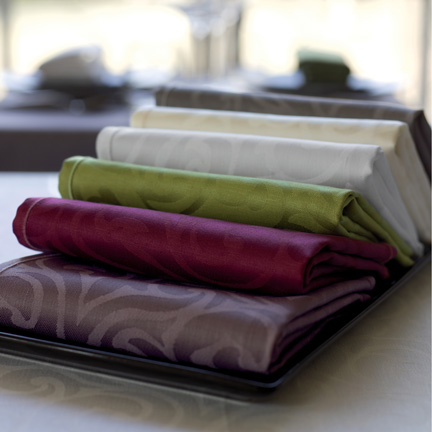
What colors should my table linens be?
White is the most popular color for table linens and it is always appropriate for formal dining. Ivory and off-white colors are a popular second, especially in rooms with warmer tones. Beyond these, colors are wonderful for highlighting special elements in your tabletop collections or to celebrate festive occasions.
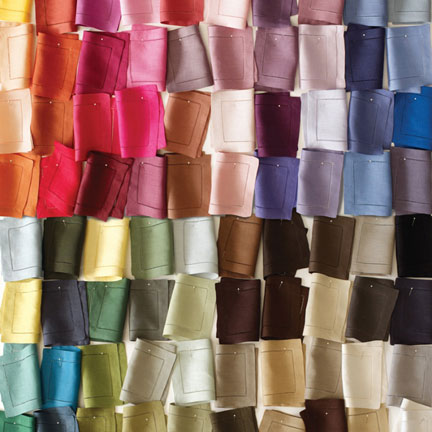
What should I consider in choosing linens for a special event?
– Location: Choose colors to complement the existing décor of your dining room. For outdoor events, let the setting be your guide. Generally, bright colors look better in sunny locations, while pastels are wonderful in garden settings.
– Season: Spring and summer colors tend to be lighter, while bolder colors are more appropriate during the colder fall and winter months.
– Theme: Colorful linens are one of the most effective ways to set the mood you want to create. Vibrant colors add drama, while soft colors evoke a more refined atmosphere.

Protecting Your Tables
Why do I need a table liner?
Although designed to last a lifetime, fine table surfaces are often exposed to excessive wear and tear. To help protect your tables, thick felt table liners are designed to reduce noise and protect your tabletop against heat and scratches. Unlike ordinary liners, these are plush and generously sized (approximately 5″ larger than your table) to extend over the edge of your table in order to create a softer drape underneath your fine linens. To read more, see Protecting Your Table with Felt Liners.
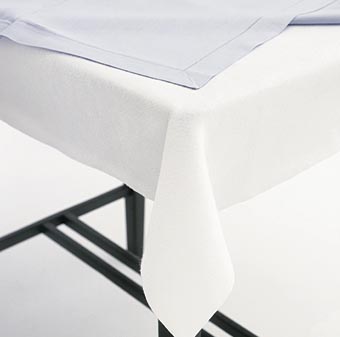
What size table liner do I need?
We suggests choosing a table liner that is slightly smaller than your tablecloth (but larger than your table.) Following are our recommended sizes:
| Tablecloth | Felt Liner |
| 70″ x 90″ | 60″ x 82″ |
| 70″ x 108″ | 60″ x 100″ |
| 70″ x 126″ | 60″ x 118″ |
| 70″ x 144″ | 60″ x 136″ |
| 70″ x 162″ | 60″ x 154″ |
| 70″ x 180″ | 60″ x 172″ |
| 88″ x 106″ | 78″ x 96″ |
| 88″ x 124″ | 78″ x 114″ |
| 88″ x 140″ | 78″ x 130″ |
| 88″ x 160″ | 78″ x 150″ |
| 70″ round | 60″ round |
| 90″ round | 80″ round |
| 108″ round | 90″ round |
Caring for Table Linens
How do I care for my table linens?
Most fine linens can be laundered at home. Cottons and linens should be washed with like colors in cool water using a regular (non-bleach) detergent. Stains should be treated as soon as possible using a stain remover such as our LeBlanc Linen Wash. Bleaching agents such as chlorine, peroxide, or sodium carbonate should not be used.
Linens can be dried, but should be removed from the dryer while slightly damp in order to minimize wrinkles. They should then be spread on a large surface and pressed with a hot iron. When ironing embroideries, place them face down on a towel and press on the reverse side.
Taffetas, silks and laces should generally be dry cleaned, especially if the items are delicate or have decorative fringes.
Are there specialty linen cleaning solutions?
LeBlanc Linen Wash is a specially formulated cleaning solution for laundering fine linens. Its gentle, pH-balanced formula may be used on all natural fibers, synthetics, and blends. We particularly like it because it is concentrated, so it is effective on linens (including vintage linens) without the use of bleach, caustics, or phosphates. LeBlanc Linen Wash has been tested to remove lipstick, jam and jelly, fruit juice, coffee, tea, chocolate, red, wine, grease, cola, ink, and oil stains.
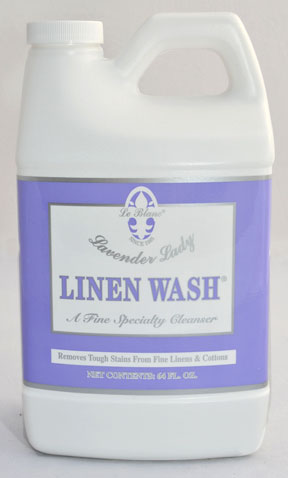
Do I have to iron my fine table linens?
For formal dining, we do recommend that you iron your fine linens. After washing, simply lay your slightly damp linens on your table over large towels or a felt table liner and press with a hot iron. Of course, you may also have your linens professionally pressed for a small charge.
How do I store my table linens?
Preparing linens for storage is easy. Make sure linens are completely clean and dry. Avoid starching them prior to storage. Fold items gently and store them in a cool, dry, and well-ventilated area. Do not store linens in plastic bags or cedar chests or in basements, attics, or garages to prevent large fluctuations in humidity and temperature. Check your linens periodically to ensure that they are clean and dry.
Guide to Choosing Flatware
There are so many exciting choices in flatware, you are probably asking yourself, “Where do I start? Which material should I select, and how many pieces will I need?” We break down the basics for you, so your table will look fabulous in no time flat.
Understanding Flatware Materials
What are the different types of materials used to make dinnerware?
Sterling: Sterling silver flatware collections are true heirlooms. Sterling is made of at least 92.5% pure silver and an alloy (usually copper for added strength). Any piece of flatware that meets these guidelines is stamped with the word “sterling” to ensure its authenticity. Sterling silver is very expensive, but it makes the most elegant and formal flatware. Compared to stainless, sterling has a warmer glow and may require occasional polishing. When not in use for prolonged periods, we advise keeping sterling in felt pouches to prevent scratches or tarnish.
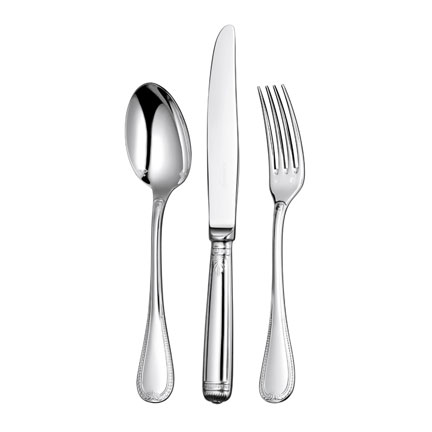
Silverplate: Silverplate is a dishwasher-safe, less-expensive alternative to sterling that can last nearly as long. A layer of 100% silver coats another metal, usually nickel or brass. Nickel is best, because it’s harder than brass and silver adheres to it well. The thicker the silver layer, the better the quality.
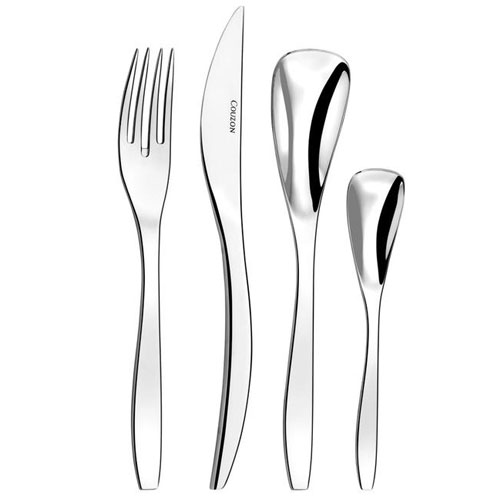
Stainless Steel: Most everyday flatware is stainless steel, which doesn’t rust, tarnish, chip, or wear out. Stainless steel is commonly defined as a metal alloy that contains a minimum of 10.5% chromium. To make stainless steel flatware, chromium is added to steel for strength as well as rust and stain resistance. Nickel, another metal alloy, is also added to the steel for its brilliance and lasting finish. The grades (18/10, 18/8, and 18/0) refer to the amount of nickel, which prevents corrosion. The best grade is 18/10, because it is the longest lasting.
Why is stainless steel “stainless”?
Compared to other metals, stainless steel is particularly resistant to rust and discoloration because the oxide film in the metal absorbs common forms of discoloration. Keep in mind, however, that while stainless steel certainly stains less, it is not completely stain proof.
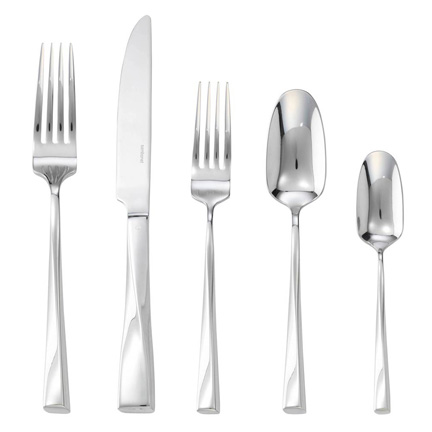
Pewter: In colonial America, pewter was prized for its strength and durability. Today, pewter products are sought after by collectors for their rustic feel and beautiful patina. Pewter does not require polishing.
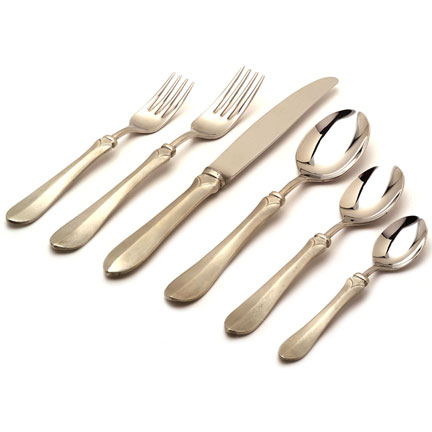
PVD: Is a thin ceramic coating deposited on stainless steel pieces, resulting in colored implements. It is very hard and resists abrasion well.
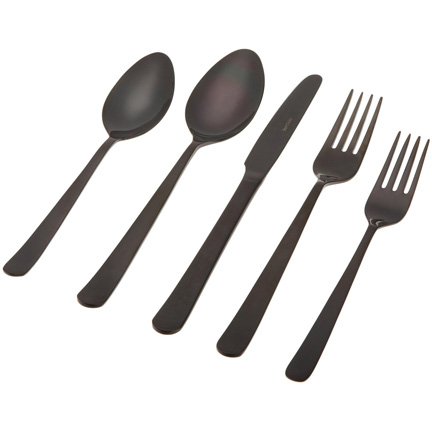
Acrylic: Acrylic flatware with colored and patterned handles is sold in a rainbow of styles. Fashionable enough for formal events, it’s also great for everyday use. Q Squared’s London Chic collection, and Vietri’s best-selling Aladdin collection, are perfect for adding personality to your table setting.
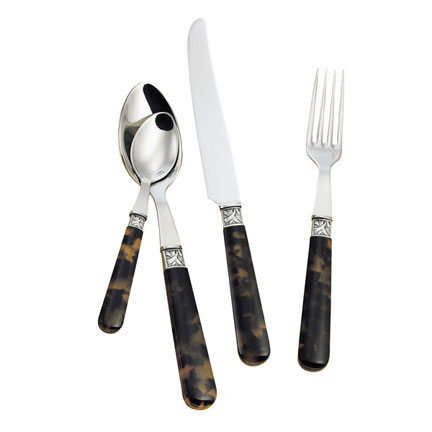
Suggested quantities
What is included in a five-piece setting?
Five-piece place settings consist of the following: dinner knife, dinner fork, salad fork, tablespoon and teaspoon.
Can I order additional flatware pieces?
Yes. In addition to five-piece settings, additional pieces such as butter spreaders, fish forks and knives, demitasse spoons, salad servers, cake servers and gravy ladles are standard items in many collections. Please write us at service@graciousstyle.com for further information on any of our collections.
How many flatware collections do I need?
Generally, most people have at least one casual collection for everyday use (usually stainless steel) and one formal collection for selected occasions (usually sterling or silverplated).
What serving pieces do I need?
– Twelve five-piece settings
– One serving set (serving knife and serving fork)
– One salad serving set
– One carving set
– One set of steak knives
– One cake server
Caring for Flatware
How do I care for stainless steel flatware?
Stainless steel flatware is dishwasher safe; it can also can be washed by hand.
How do I care for silverplated or sterling flatware?
The best way to keep sterling and silverplated lustrous is to use it regularly. For optimal care, wash silver flatware in hot water with mild soap and dry immediately afterward with a soft cloth. Do not wash sterling and stainless together, as the steel will scratch the silver. Use a small amount of detergent, and one with no lemon or citrus additives.
To clean individual pieces of silver, you can use a high-quality silver polish or foam (such as Christofle Cream Cleaner with Sponge). To view all our metal cleaning products and storage cases, click here.
However, to clean many pieces simultaneously, we suggest the following quick-clean method:
1) Boil a pot of medium pot of water.
2) Line a pan with aluminum foil.
3) Place your flatware pieces inside the pan, one next to each other.
4) Pour boiling water over the flatware.
5) Add a few tablespoons of baking soda to your pan. While the solution bubbles up, watch the tarnish disappear from your flatware and onto the aluminum foil. Try this, it really works!
How do I store my flatware?
We recommend that you enjoy your flatware as much as possible. However, when not in use, flatware can be stored in a kitchen drawer (designated for this use) or kept inside felt bags. Do not wrap in plastic or paper, and do not crowd pieces to avoid scratching.

Miscellaneous
What is the difference between standard and continental sizes?
Standard refers the sizes of flatware commonly used with American table settings. However, for a more formal look, there are “continental” flatware sizes (also referred to as “dinner” sizes) that are larger and heavier than the standard. These are usually found in European flatware collections.
What is the proper placement of flatware on the table?
A basic five-piece setting is laid out on the table in order of use, in an even line, one inch from the edge of the table. The knife is placed to the right of the plate with the sharp edge pointed in towards the plate. The spoons are placed to the right of the knife. Forks are placed to the left of the plate. In France the fork is placed with the prongs facing down towards the table (the spoons are also placed facing downward); in the United Kingdom and the United States they face upwards.

To view all our collections of flatware, click here.
Registry Checklist: Getting Yourself Organized
Congratulations on your engagement! It’s time to pick a date, spread the word and celebrate with the biggest party of your life. To help keep you on track and save you some stress, we look to Martha Stewart for the perfect wedding calendar checklist. From setting your budget to packing for your honeymoon, this list will help you breeze through your wedding plans, all the way up to “I do”!

Click here to print Martha’s checklist!
Guide to Choosing Bed Linens
We typically spend a third of our lives in our bedroom, so be sure to get a set of linens you’ll love using over and over again.
Understanding Bedding Materials
What should I look for in finer linens?
Finer linens are usually characterized by a combination of beautiful materials, expert construction, and design. Most fine linens are made from linen or cotton because they are durable, absorbent, and they become softer with use and laundering.
Finer linens are smooth and soft (no coarse knots or uneven slubs should be visible); they may also be lustrous, but never shiny. Workmanship is key: all designs must be precisely executed, all colors uniform, and all seams must be finished evenly to ensure they’ll last for years.
What is the difference between linen and cotton?
Both linen and cotton are natural fibers: linen comes from the flax plant and cotton comes from the cotton plant. Both fabrics are highly absorbent, durable, and become softer with use. Generally, linen feels lighter and has more texture, but it requires pressing after use. Cotton, on the other hand, feels more substantial and is better for reproducing printed designs. It is by far the most popular choice for bedding, so it is more widely available and generally more affordable.
What is Egyptian cotton?
Because the humid weather and rich soil around the Nile delta produce especially delicate and long fibers, Egyptian cotton is by far the finest variety of cotton in the world. These longer fibers allow for a finer, more continuous thread, and a higher number of threads per square inch, resulting in a stronger and softer material.
What is sateen?
Sateen is cotton made with a satin weave. Rather than a one-over-one weave like percale, the warp or weft threads passed over several filling threads, creating a fabric with a silken feel and a very smooth and lustrous surface. Sateens can be produced in both light and heavy weights; they should ideally be ironed after washing to restore their luster.
What is percale?
Percale is a closely woven, plain weave, meaning that the warp and weft threads cross each other one at a time. They are a tighter weave with a thread count of at least 180. Percale can be made of any fiber but are usually cotton or a cotton/polyester blend.
Why is thread count so important?
The term “thread count” refers to the number of threads in one square inch of fabric. Higher thread counts mean a tighter weave, a softer and stronger fabric, and a finer quality. For a luxurious feel, we recommend fabrics with at least 300 thread count.
While important, thread count should always be considered in conjunction with the quality of the fiber, workmanship and finishing process used on the linens. Always make sure that the highest quality fiber is used because a high thread count sheet made from lower quality fibers will feel heavy and coarse instead of soft and luxurious.
Choosing a Size
What are standard mattress sizes?
| Twin | 39″ x 75″ |
| Full (Double) | 54″ x 75″ |
| Queen | 60″ x 80″ |
| King | 76″ x 80″ |
| California King | 72″ x 84″ |
What are the dimensions of your bed linens?
Actual dimensions vary between collections, but they are generally as follow:
| Neckroll | 16″ x 20″ |
| Boudoir shams | 12″ x 16″ |
| Standard pillowcase | 21″ x 33″ |
| Queen pillowcase | 21″ x 39″ |
| King pillowcase | 21″ x 43″ |
| Standard shams | 20″ x 27″ |
| King shams | 20″ x 37″ |
| Euro shams | 26″ x 26″ |
| Twin Flat | 71″ x 110″ |
| Full Flat | 87″ x 110″ |
| Queen Flat Sheet | 95″ x 118″ |
| King Flat Sheet | 108″ x 120″ |
| Twin Fitted Sheet | 39″ x 76″ x 17″ |
| Full Fitted Sheet | 54″ x 76″ x 17″ |
| Queen Fitted Sheet | 60″ x 80″ x 17″ |
| King Fitted Sheet | 78″ x 80″ x 17″ |
| Cal King Fitted Sheet | 72″ x 84″ |
| Twin Duvet Cover | 64″ x 86″ |
| Full Duvet Cover | 82″ x 90″ |
| Queen Duvet Cover | 90″ x 90″ |
| King Duvet Cover | 104″ x 90″ |
Care and Suggested Quantities
How do I care for my bed linens?
You should always wash your bed linens before putting them on your bed for the first time. Be sure to wash your sheets regularly (remember that natural fibers get softer with each wash) in warm water with like colors and tumble dry on medium. Do not use bleach or fabric softener because it can damage fibers and make the sheets less soft over time. For less wrinkle in your sheets, remove them promptly from the dryer and put them on the bed or fold them right away. If you do want to iron your bed linens, take out of the dryer slightly damp for easier ironing, and always press embroideries on the reverse side.
How many bed linens do I need?
We recommend that a basic collection of bed linens include one set for the bed, one set for the laundry, and one set for the linen closet. A full list of recommended items includes:
- 3 Complete sheet sets (flat, fitted, 2 pillowcases each)
- 1 Medium or heavyweight comforter
- 2 Blankets or throws (1 light for summer, 1 heavy for winter)
- 2 Pillow shams in the size of your choice (standard, queen, king)
- 2 Decorative pillow shams (boudoir or neck roll)
- 1 Duvet cover
- 1 Bed skirt
- 1 Mattress pad
- 1 Complete sheet set per guestroom
- 1 Blanket per guestroom
Who Is Gracious Style?
Gracious Style is the lifestyle destination for the sophisticated and well-traveled individual. Whether you’re looking to throw a fabulous dinner party, redecorate your master bathroom, or find a special gift for someone, we bring you all the little things you need to live life well.
We understand how you want to live today. Like you, we’re busy and constantly flying from one country to the next. But no matter where we are, we care about how things are made, and we want them to last us for years. We want things that are exquisite, but we need them to work with everything else we already own. And of course, we only want to surround ourselves with objects that we’ll reach for again and again.
So this is what we’ve done. We’ve culled through thousands and thousands of items and brought you only the very best ones. Some you’ll recognize (like Christofle flatware and Yves Delorme bedding) while others will be new (like Mario Luca Giusti drinkware). But no matter when or where they were made, you’ll see that they will all work together to create a look that’s just perfect for you.
Founded in 1999, Gracious Style has been featured in numerous publications and television segments including The Wall Street Journal, Southern Accents, Departures, and Elle Decor. We have worked with sophisticated clients and some of the world’s best-known interior designers and architects to furnish private homes, yachts, jets, hotels, restaurants, and embassies. We look forward to hearing from you soon. Welcome to Gracious Style.
For more about our history and passion, check out our blog!
Guide to Choosing Bath Linens
You use your bathroom every day, so it’s time to show it some love! Bath linens are an everyday essential, so here are some key factors to keep in mind when making your selections.
Understanding Bath Linen Materials
What quality should I look for in bath linens?
Material is the most important consideration when purchasing bath linens. Almost all fine towels are made from cotton (especially Egyptian and Turkish) because it is very absorbent and strong. Microfiber (high performance synthetic fibers that resist shedding and piling) and bamboo are becoming increasingly popular because they are even more absorbent and lighter in weight.
What is terry cloth?
Terry refers to the looped pile you see on most towels. The longer and more tightly packed these loops are, the more absorbent and durable the towel. Terry cloth towels are absorbent because the looped pile in the terry acts like very small sponges.
What is microfiber?
Microfiber is an ultrafine fiber that naturally resists shedding and piling. Compared with other materials, microfibers are twice as fine as silk and three times finer than cotton. Items made from microfiber are extremely absorbent, soft, and lightweight.
Choosing a Size
What are standard towel sizes?
Sizes will vary among different collections, but they are generally as follow:
| Bath Sheet | 47″ x 59″ |
| Bath Towel | 27″ x 55″ |
| Hand Towel | 24″ x 41″ |
| Guest Towel | 16″ x 24″ |
| Washcloth | 13″ x 13″ |
| Bath Mat | 24″ x 35″ |
| Shower Curtain | 72″ x 72″ |
How do I select a bathrobe?
When choosing a bathrobe, comfort is key. Pick a material that is soft and absorbent, but not too tight. You want to leave enough room for a bulky sweater underneath during the cold winter months.
Care and Suggested Quantities
How do I care for my bath linens?
You should always launder new towels before using them. Wash with a mild detergent in warm water and then tumble dry. Do not wash with other laundry, as shedding or “linting” almost always occurs with new towels. Avoiding using bleaches or fabric softeners.
How many towels do I need?
- 2 Bath Towels or Bath Sheets per person
- 2 Hand Towels per person
- 2 Guest or Fingertip Towels per person
- 4 Washcloths per person
- 1 Bath Mat per bathroom
- 1 Shower Curtain and Liner per bathroom
- 2 Additional Towel Sets (bath, hand, guest) for each additional bathroom
Party Ideas: Garden Party
Hats, dresses, finger sandwiches, champagne and flowers. What more could one ask for? Before you invite your friends over and start preparing your menu, consider the details you want to focus on for your celebration. Flowers, candles and tea cups are quick way to set up the ambiance. If you want more inspiration, accent pieces like Rosenthal’s Butterfly Garden series (and the smell of roses) will help you be your way to a successful garden party in no time!
Garden Party Musts
Table linens can change the entire look of any occasion. Consider the overall feel you want to achieve before selecting your table linen. Whites are a classic choice but any neutral, solid or patterned table cloth could take your party to the next level.
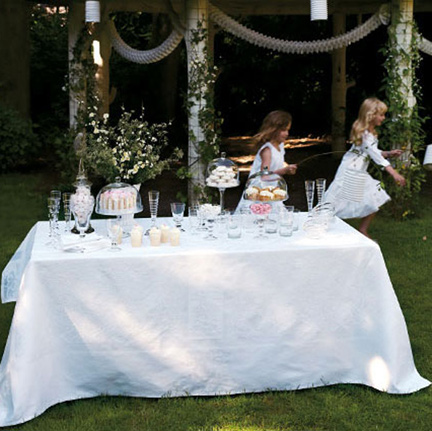
For more great Party Ideas click here!






